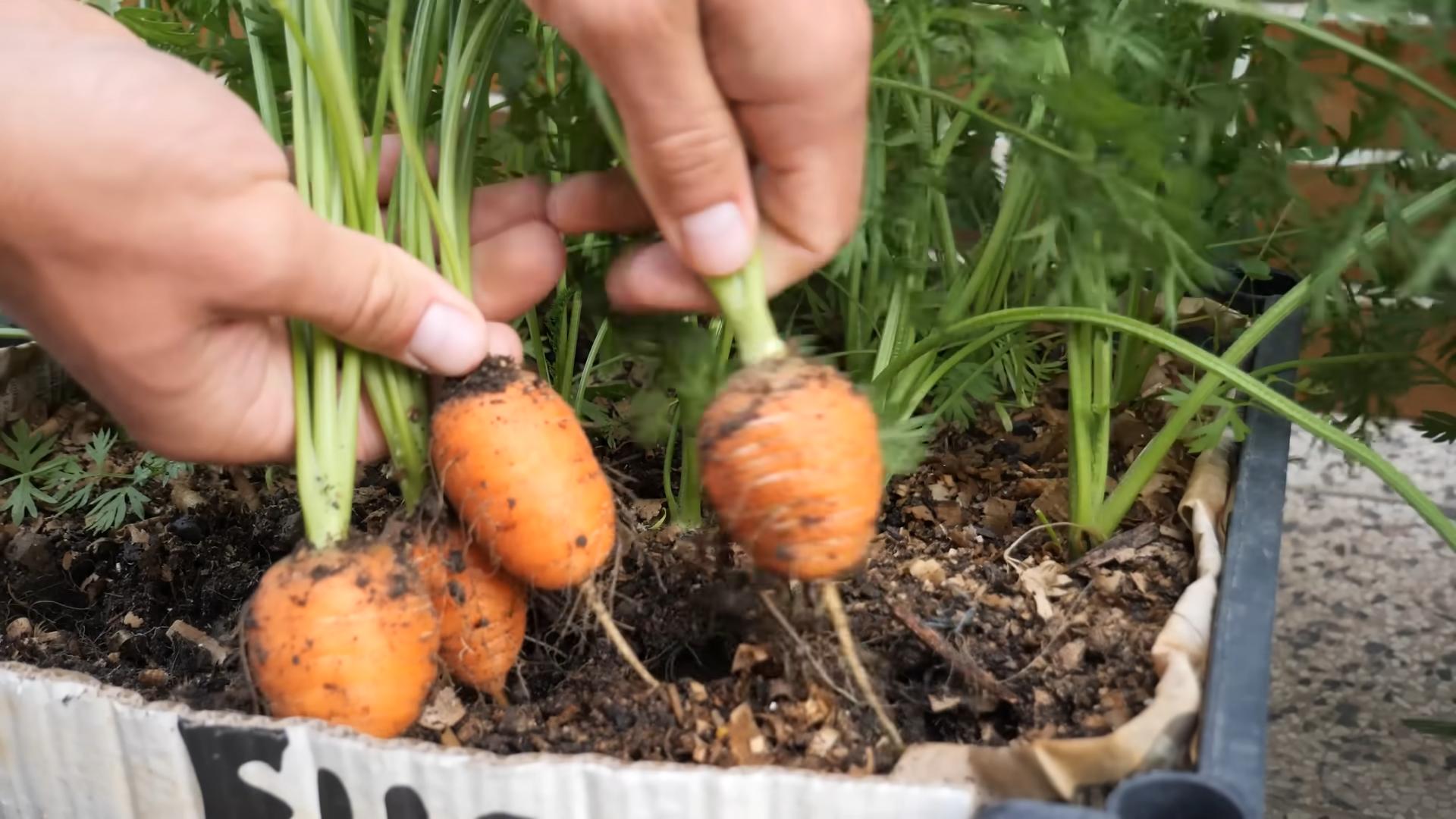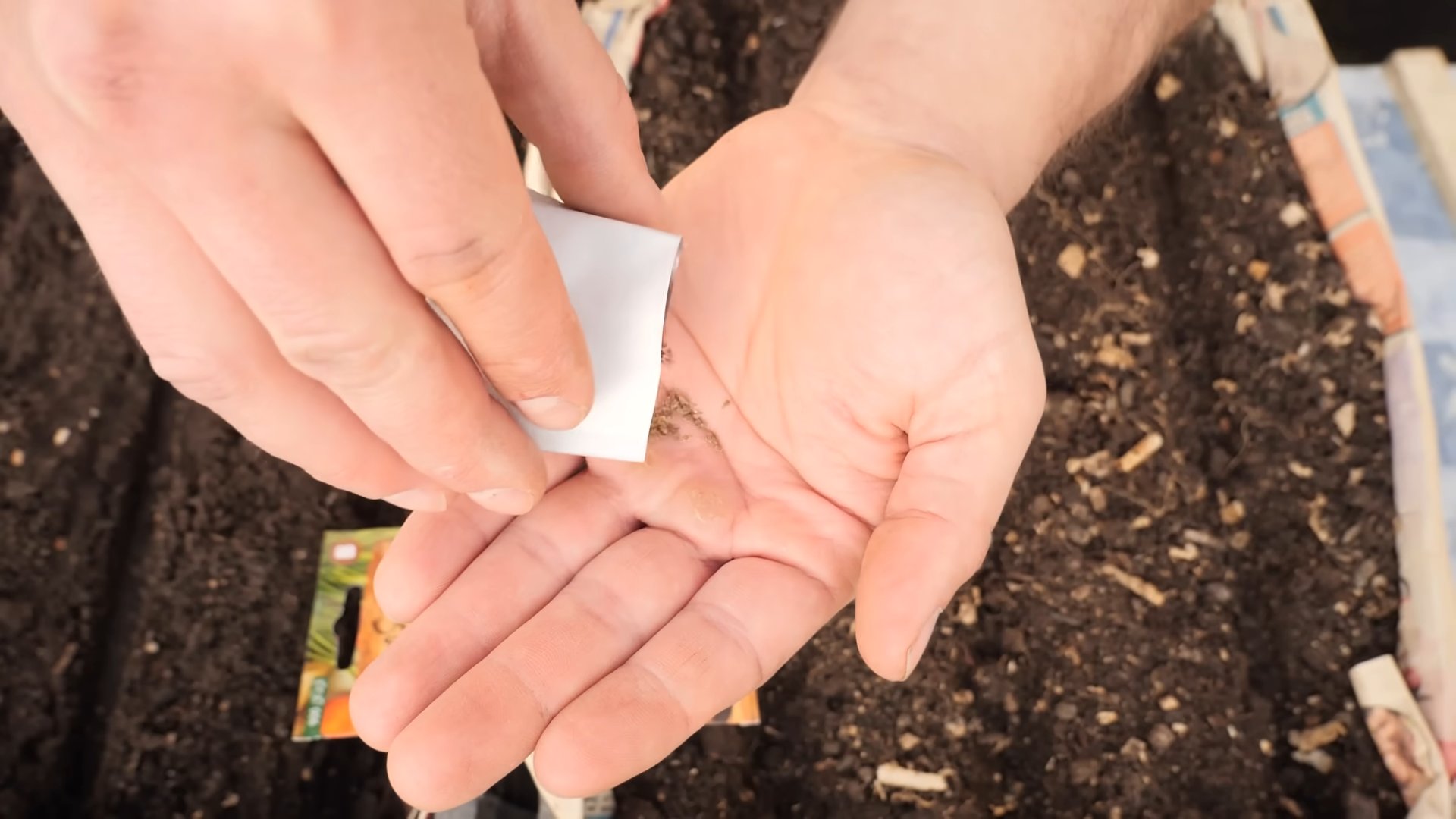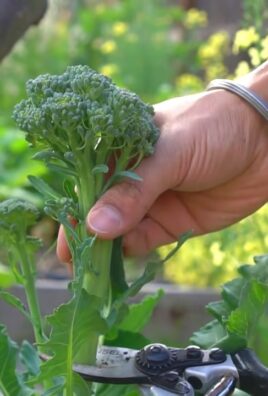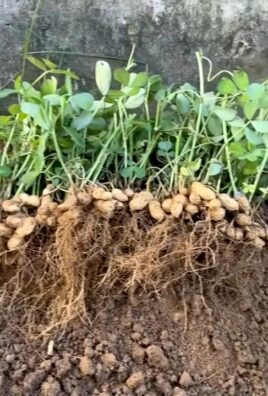Growing Carrots at Home might seem daunting, conjuring images of sprawling farms and endless rows of orange delights. But what if I told you that you could cultivate these crunchy, sweet vegetables right in your own backyard, balcony, or even windowsill? Forget those bland, store-bought carrots – imagine the vibrant flavor and satisfying crunch of a carrot you nurtured from seed to harvest!
For centuries, carrots have been a staple in diets worldwide, with their cultivation dating back to ancient times. Originally, they weren’t even orange! Purple, yellow, and white varieties were common before the Dutch selectively bred the orange carrot we know and love today. Now, you can join this rich history by embarking on your own carrot-growing adventure.
Why should you bother with growing carrots at home? Well, beyond the sheer joy of gardening, homegrown carrots are simply superior. They’re fresher, often sweeter, and free from the pesticides and herbicides that can sometimes plague commercially grown produce. Plus, learning these simple DIY tricks and hacks will empower you to connect with nature, reduce your carbon footprint, and enjoy a delicious, healthy snack straight from your garden. So, grab your gardening gloves, and let’s dive into the wonderful world of homegrown carrots!

Growing Carrots at Home: A Beginner’s Guide to Sweet Success!
Hey there, fellow gardening enthusiasts! I’m so excited to share my experience and tips on growing carrots right in your own backyard (or even in containers!). Carrots are a fantastic addition to any garden, offering a rewarding harvest of crunchy, sweet goodness. Plus, homegrown carrots just taste *so* much better than store-bought ones. Let’s dive in!
Choosing the Right Carrot Variety
Before we get our hands dirty, let’s talk about carrot varieties. There are tons to choose from, and the best one for you will depend on your climate, soil type, and personal preference. Here’s a quick rundown:
* Nantes: These are classic, cylindrical carrots with a sweet flavor and smooth skin. They’re relatively short and mature quickly, making them a great choice for beginners.
* Danvers: These are longer, tapered carrots with a slightly stronger flavor. They’re known for their good storage capabilities.
* Chantenay: These are short, thick, and cone-shaped, making them ideal for heavy or rocky soils. They’re also very sweet.
* Imperator: These are the long, slender carrots you often see in supermarkets. They require deep, loose soil to grow properly.
* Round Carrots (Parisian): These are adorable, golf-ball-sized carrots that are perfect for containers or shallow soils.
I personally love growing Nantes and Chantenay varieties because they’re relatively easy to grow and have a fantastic flavor.
Preparing Your Carrot Patch
Carrots need loose, well-drained soil to thrive. Rocky or compacted soil will result in stunted, misshapen carrots. Here’s how to prepare your garden bed:
* Sunlight: Carrots need at least 6 hours of sunlight per day. Choose a sunny spot in your garden.
* Soil Testing: It’s always a good idea to test your soil’s pH. Carrots prefer a slightly acidic soil with a pH between 6.0 and 6.8. You can buy a soil testing kit at most garden centers.
* Soil Amendment: This is the most crucial step! Carrots need loose soil to grow straight and long.
* Dig Deep: Dig down at least 12 inches, removing any rocks, stones, or debris.
* Add Organic Matter: Mix in plenty of compost, well-rotted manure, or other organic matter to improve drainage and fertility. I usually add a generous layer of compost, about 2-3 inches thick.
* Loosen the Soil: Use a garden fork or tiller to loosen the soil thoroughly. Break up any clumps and make sure the soil is nice and crumbly.
* Avoid Fresh Manure: Fresh manure can cause forked roots, so it’s best to use well-rotted manure or compost.
* Raised Beds: If you have heavy clay soil, consider growing carrots in raised beds. This will improve drainage and make it easier to control the soil quality.
Planting Carrot Seeds
Carrot seeds are tiny, so planting them can be a bit tricky. But don’t worry, I’ll walk you through it!
1. Timing is Key: Carrots are a cool-season crop, so the best time to plant them is in early spring (2-3 weeks before the last expected frost) or late summer (for a fall harvest). Check your local frost dates to determine the best planting time for your area.
2. Create Furrows: Use a hoe or your finger to create shallow furrows in the soil, about 1/4 to 1/2 inch deep. Space the furrows about 2-3 inches apart.
3. Sow the Seeds: Sprinkle the carrot seeds evenly along the furrows. Carrot seeds are notoriously small, so it’s easy to sow them too thickly. Try to space them about 1/2 inch apart. If you sow them too close together, you’ll need to thin them later.
4. Cover the Seeds: Gently cover the seeds with a thin layer of soil.
5. Water Gently: Water the soil gently with a watering can or hose with a gentle spray nozzle. Be careful not to wash away the seeds.
6. Keep the Soil Moist: Keep the soil consistently moist until the seeds germinate. This may require watering daily, especially in warm weather.
7. Mark Your Rows: Label your rows with the carrot variety and planting date. This will help you keep track of your progress.
Thinning Your Carrot Seedlings
Once your carrot seedlings emerge (usually in 1-3 weeks), it’s crucial to thin them out. Thinning allows the remaining carrots to develop properly without being crowded.
1. Wait Until Seedlings are 1-2 Inches Tall: Wait until the seedlings are about 1-2 inches tall before thinning them.
2. Thin to 1-2 Inches Apart: Thin the seedlings to about 1-2 inches apart. You can use small scissors to snip off the unwanted seedlings at the soil line, or gently pull them out. Be careful not to disturb the roots of the remaining seedlings.
3. Second Thinning (Optional): When the carrots are about 4 inches tall, you can thin them again to about 3-4 inches apart. This will give them even more room to grow.
4. Don’t Waste the Thinnings: You can eat the thinned carrot greens! They have a mild carrot flavor and can be added to salads or soups.
Caring for Your Carrot Plants
Carrots are relatively low-maintenance, but they do need regular care to thrive.
* Watering: Water your carrot plants regularly, especially during dry spells. Carrots need consistent moisture to develop properly. Aim for about 1 inch of water per week.
* Weeding: Keep your carrot patch free of weeds. Weeds compete with carrots for nutrients and water. Hand-pull weeds carefully to avoid disturbing the carrot roots.
* Fertilizing: Carrots don’t need a lot of fertilizer, but a light feeding of a balanced fertilizer can help them grow. Apply the fertilizer according to the package directions. Avoid over-fertilizing, as this can cause forked roots.
* Mulching: Apply a layer of mulch around your carrot plants to help retain moisture, suppress weeds, and regulate soil temperature. Straw, hay, or wood chips are good choices for mulch.
* Pest Control: Carrots are susceptible to a few pests, such as carrot rust flies and nematodes.
* Carrot Rust Flies: These flies lay their eggs near the base of carrot plants, and the larvae burrow into the roots, causing damage. Cover your carrot plants with row covers to prevent the flies from laying their eggs.
* Nematodes: These microscopic worms can damage carrot roots. Rotate your crops regularly to prevent nematode infestations. You can also amend your soil with beneficial nematodes, which prey on harmful nematodes.
Harvesting Your Carrots
The moment you’ve been waiting for! Harvesting your carrots is the most rewarding part of the process.
1. Check Maturity Dates: Check the seed packet for the maturity date of your carrot variety. This will give you an idea of when your carrots will be ready to harvest.
2. Look for Shoulder Exposure: You can also check the size of the carrot shoulders (the top part of the carrot that’s visible above the soil). If the shoulders are about 1/2 to 1 inch in diameter, the carrots are likely ready to harvest.
3. Loosen the Soil: Before pulling the carrots, loosen the soil around them with a garden fork. This will make it easier to pull them out without breaking them.
4. Grasp the Greens: Grasp the carrot greens firmly near the base of the plant.
5. Pull Gently: Pull the carrot straight up out of the ground. If the carrot is stuck, try wiggling it gently from side to side.
6. Wash and Store: Wash the carrots thoroughly to remove any dirt. Cut off the greens, leaving about 1/2 inch of stem. Store the carrots in the refrigerator in a plastic bag or container. They should keep for several weeks.
Troubleshooting Common Carrot Problems
Even with the best care, you might encounter some problems while growing carrots. Here are a few common issues and how to address them:
* Forked Roots: Forked roots are often caused by rocky or compacted soil. Make sure to prepare your soil properly by removing rocks and adding organic matter. Fresh manure can also cause forked roots, so use well-rotted manure or compost.
* Stunted Growth: Stunted growth can be caused by poor soil, lack of sunlight, or pests. Make sure your carrots are getting enough sunlight and water, and that your soil is well-drained and fertile. Check for pests and take appropriate action if necessary.
*

Conclusion
So, there you have it! Growing carrots at home, especially with this simple DIY trick, is not only achievable but also incredibly rewarding. Forget those bland, store-bought carrots that lack that vibrant, earthy sweetness. Imagine pulling your own, perfectly formed carrots straight from the soil, bursting with flavor and packed with nutrients. This isn’t just about saving money; it’s about connecting with your food, understanding the growing process, and enjoying the unparalleled taste of homegrown produce.
This DIY method, focusing on [mention the specific DIY trick if it was explained in the main article, e.g., “using coffee grounds to amend the soil” or “creating a carrot seed tape”], offers a significant advantage over traditional planting methods. It addresses common challenges like seed spacing, soil compaction, and pest control, leading to a higher success rate and a more bountiful harvest. Plus, it’s a fantastic way to get the whole family involved in gardening, teaching children about where their food comes from and fostering a love for the natural world.
But the beauty of gardening lies in its adaptability. Feel free to experiment with different carrot varieties. Consider Nantes for their classic shape and sweet flavor, Chantenay for their shorter, sturdier roots ideal for heavier soils, or even colorful varieties like Purple Haze or Yellow Stone for a visually stunning harvest. You can also try companion planting. Marigolds, for example, are known to deter nematodes, while rosemary can repel carrot flies.
Don’t be afraid to adjust the DIY trick to suit your specific needs and resources. If you don’t have access to [mention a specific material used in the DIY trick], explore alternatives. The key is to understand the underlying principles – proper soil preparation, adequate drainage, and consistent watering – and adapt the method accordingly.
Growing carrots at home is more than just a gardening project; it’s an investment in your health, your well-being, and your connection to the earth. It’s a chance to experience the satisfaction of nurturing something from seed to table, and to savor the unparalleled flavor of homegrown produce.
So, what are you waiting for? Grab your seeds, prepare your soil, and give this DIY trick a try. We’re confident that you’ll be amazed by the results. And most importantly, we want to hear about your experience! Share your photos, tips, and challenges in the comments below. Let’s build a community of carrot-growing enthusiasts and learn from each other’s successes and failures. Happy gardening!
Frequently Asked Questions (FAQ)
Q: What is the best time of year to plant carrots?
A: Carrots are a cool-season crop, meaning they thrive in cooler temperatures. The best time to plant carrots is typically in early spring, about 2-3 weeks before the last expected frost. You can also plant a second crop in late summer or early fall for a fall harvest. In warmer climates, you can even grow carrots throughout the winter. The key is to avoid planting during the hottest months of the year, as high temperatures can cause the roots to become bitter and stunted. Check your local planting calendar for specific dates based on your region’s climate.
Q: What kind of soil is best for growing carrots?
A: Carrots need loose, well-drained soil to grow properly. Rocky or compacted soil can cause the roots to become misshapen or stunted. Ideally, the soil should be sandy loam, which is a mixture of sand, silt, and clay. Before planting, amend the soil with plenty of compost or well-rotted manure to improve drainage and fertility. Avoid adding fresh manure, as it can cause the roots to fork. Also, ensure the soil is free of rocks and debris that could impede root growth. A slightly acidic soil pH of 6.0 to 6.8 is ideal for carrot growth.
Q: How often should I water my carrots?
A: Carrots need consistent moisture to thrive, especially during germination and early growth. Water deeply and regularly, aiming for about 1 inch of water per week. Avoid letting the soil dry out completely, as this can cause the roots to crack. However, be careful not to overwater, as this can lead to root rot. Use a soaker hose or drip irrigation to deliver water directly to the roots, minimizing water loss through evaporation. Mulching around the plants can also help retain moisture in the soil.
Q: How do I prevent carrot flies from damaging my crop?
A: Carrot flies are a common pest that can damage carrot roots. The larvae burrow into the roots, causing them to become riddled with tunnels and making them unmarketable. There are several ways to prevent carrot fly damage. One effective method is to cover your carrot bed with a fine mesh netting or row cover. This will prevent the adult flies from laying their eggs near the plants. You can also plant carrots alongside strong-smelling herbs like rosemary or sage, which can deter the flies. Another option is to practice crop rotation, avoiding planting carrots in the same location year after year. Finally, remove any infected carrots promptly to prevent the flies from spreading to other plants.
Q: When and how should I thin my carrot seedlings?
A: Thinning carrot seedlings is crucial for ensuring that the remaining plants have enough space to grow properly. When the seedlings are about 1-2 inches tall, thin them to about 1-2 inches apart. Then, when they are about 4-6 inches tall, thin them again to about 3-4 inches apart. To thin the seedlings, gently pull them out of the soil, being careful not to disturb the roots of the remaining plants. Water the area after thinning to help settle the soil. Thinning is best done on a cloudy day or in the evening to minimize stress on the plants.
Q: How do I know when my carrots are ready to harvest?
A: Carrots are typically ready to harvest when they reach the desired size and color. The exact time will depend on the variety of carrot you are growing. Generally, carrots are ready to harvest about 60-80 days after planting. To check if they are ready, gently loosen the soil around the top of the carrot and pull one out. If it is the size you want, you can harvest the rest. You can also leave carrots in the ground for longer, but they may become tougher and less sweet. Harvest carrots on a dry day to prevent them from rotting.
Q: Can I grow carrots in containers?
A: Yes, you can definitely grow carrots in containers! Choose a container that is at least 12 inches deep to accommodate the length of the carrot roots. Use a well-draining potting mix and make sure the container has drainage holes. Follow the same planting and care instructions as you would for growing carrots in the ground. Container-grown carrots may need more frequent watering than those grown in the ground, as the soil in containers tends to dry out more quickly. Dwarf or shorter varieties of carrots are particularly well-suited for container gardening.
Q: What are some common problems when growing carrots and how can I fix them?
A: Some common problems when growing carrots include forked roots, stunted growth, and pest infestations. Forked roots can be caused by rocky or compacted soil. To prevent this, make sure the soil is loose and well-drained, and remove any rocks or debris before planting. Stunted growth can be caused by nutrient deficiencies or lack of water. Amend the soil with compost or fertilizer to provide the necessary nutrients, and water regularly to keep the soil moist. Pest infestations can be controlled with organic pesticides or by covering the plants with netting. Regularly inspect your plants for signs of pests or diseases and take action promptly to prevent them from spreading.
Q: How do I store my harvested carrots?
A: To store your harvested carrots, first remove the green tops, leaving about an inch of stem. Gently brush off any excess soil, but do not wash them. Store the carrots in a cool, dark, and humid place, such as a refrigerator or root cellar. You can store them in a plastic bag or container with a damp paper towel to help maintain humidity. Carrots can also be stored in a box of moist sand or sawdust. Properly stored carrots can last for several months.





Leave a Comment